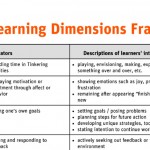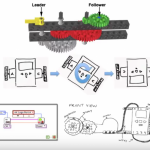It’s okay to fail, you’re on camera!
My school is in a 1:1 iPad district. Every student in our district from 2nd through 12th grade is given an iPad for use in school. As the teacher in this setting, I have been slow (aren’t we all?) to take advantage of the opportunities offered by this technology. Gradually however I have been integrating the iPads into my teaching more and more. One of the areas I have done this in is the use of video assessment.
I have always struggled with how to assess student projects with open-ended challenges in Robotics. The struggle mainly revolves around this: Failure is accepted, encouraged, and even desired in Robotics and similar types of introductory engineering classes. So how do we assess student learning if their drag racer is not super speedy or if their catapult doesn’t throw very far or very accurately?
The still-evolving answer I have come up with (and it isn’t complete or perfect) is for students to make videos about their robot and/or program, where I have them explain what they did and what they tried to do. Here is an example from the beginning unit of our class:
In the above video, students were asked to program their robots to do a “funky dance” which I described as a series of short quirky moves. They were tasked with adding sounds, graphics, and blinking lights. That was the task. The assessment was for them to create a video that showed their robot doing the dance and showed/described their program. The software they used was Clips, which is freely available on the iPad.
I like Clips because it allows you to move a picture on the screen, like a screenshot of their program, and zoom in on specific parts. This really helps when explaining their code. Here is another example from this beginning project:
Another reason why I love the Clips App is the voice-to-text feature. A lot of middle-school students are uncomfortable with the sound of their voice, so the voice-to-text option is a nice one to have. You can also see there are options for stickers, emojis, and labels. Finally, this app allows you to apply filters so the students can make themselves look like cartoons.
Of course this type of assessment is not always successful, but I can see where there are gaps in student learning by examining how they explain what they did or were trying to do. If you look at the end of this video you can see they were not quite sure about what part of their program did what:
This makes it easy for me to pinpoint what a student might be struggling with or might not understand. Our school uses online classroom management software that allows me to comment on video submissions. Those comments go straight to the students’ iPad popping up as notifications. They then have the option to redo and resubmit and I in turn receive a notification letting me know they have done so.
One of the struggles with assessment is assessing creativity. I think a lot of students and teachers think of creativity as an artist designing something cool or neat. I define creativity as trying different approaches systematically to improve their robot. In order to asses this during our catapult challenge, I had them describe or point out one thing they changed or improved on their robot.
Full disclaimer, this was an afterthought. As a result, you will hear a lot of students explaining, rather than showing changes, in the next three videos. Next time I will have them take footage of all their prototypes, not just the end result.
I don’t require my videos to be perfect or polished as that is not what I am assessing. But in each of these videos I can see that the students have completed the catapult and are able to explain one change they made to improve their design.
One of the most recent units we did was on gears. The students had to build drag racers that used gears to increase their speed. In the past there was always a question of how fast the drag racers had to go to earn a particular grade. This never really sat well with me for a number of reasons. Mainly we have a limited amount of time for each unit in my trimester (13 week) long class. This means that students could use a good gear ratio but not build a very fast car. Without a longer time period to test and prototype and rebuild their dragsters, this means that some students would build their gears correctly and still not have a very fast robot.
By changing the assessment to a video assessment I was able to see if the students really understood how the gears on their robot worked. If they really got it, they did something like this:
Often times students were able to build a robot using gears (large lead and small follower) but didn’t really understand what they had done. They clearly weren’t aware of how their gears worked our how to calculate a gear ratio. With the video assessment, I was able to see that even though their robot was fast they still had a way to go.
Assessment in a class where you are encouraging students to take chances and fail is not easy. Using videos to give the students a chance to explain what they were trying to do or what they did do allows them a chance to earn a successful grade even if they didn’t build a “perfect” robot.
Latest posts by Ian Chow-Miller (see all)
- Using Video to Assess Robotics Students - 21 November 2018
- A Week in the Life #12: Robot Monsters! - 9 February 2017
- A Week in the Life #11: Sumobot to Battlebot - 28 June 2016
- A Week in the Life #10: Candy Sorter - 27 June 2016
- A Week in the Life #9: Walk This Way… - 23 November 2015


